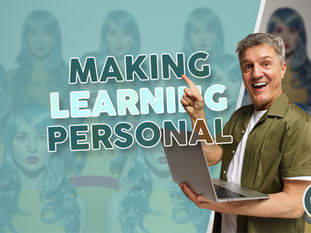
THE SCIENCE OF THE THUMBNAIL: WHY YOUR LEARNING COURSES DESERVE BETTER COVERS
0
3
0
Have you ever judged a book by its cover?
Of course you have. Everyone does. The same happens when learners open your LMS. The first thing they see is not your course content. It’s the thumbnail.
And yet, too often, that tiny square of digital real estate is treated as an afterthought. It’s uploaded at the last minute. It’s generic. Sometimes it’s just a logo or a random still image from a video.
That’s a wasted opportunity.

Because, like a book cover or a film poster, your thumbnail is your course’s invitation. It’s the first handshake between the learner and the learning.
Let’s explore why the thumbnail matters more than you might think, and how you can create one that drives engagement, curiosity and clicks.
What Netflix and YouTube Can Teach Us About Thumbnails
Netflix and YouTube have invested millions in understanding what makes people click. Every thumbnail on Netflix is tested, analysed and personalised. The platform even changes the image depending on what you’ve watched before.
YouTube creators do the same. They know that the thumbnail can make the difference between 100 views and a million.
There’s real science behind this. Our brains process images 60,000 times faster than text (MIT, 2014). In the split second before we read a course title, we’ve already made a visual judgement about whether it’s worth our time.
That’s why the thumbnail deserves the same creative attention as the content itself. It’s not decoration. It’s design with purpose.
How to Create the Perfect Course Thumbnail
Here’s how to make your course thumbnails work as hard as your learning content.
1. Start with clarity
The thumbnail must instantly tell the learner what the course is about.
Avoid abstract graphics or vague imagery. Use visual cues that connect clearly to the topic. A finance course might use coins, data or graphs. A leadership course might show people, action or confidence.
In a busy LMS, clarity beats cleverness every time.
2. Show emotion
Our eyes are drawn to faces. Especially expressive ones.
Netflix knows this. It often tests several images from the same scene to find the one with the strongest emotional impact, be it a raised eyebrow, a laugh, or a look of surprise.
For learning, use images that show real people, authentic reactions and relatable moments. Emotion sparks empathy, and empathy drives engagement.
3. Use colour and contrast wisely
Thumbnails live or die by visibility.
Use contrast to make yours stand out. Light text on dark backgrounds. Bold, clean colour combinations.
Colour also shapes emotion. Blue feels trustworthy. Orange feels energetic. Green feels calm. Choose a palette that matches the mood of the course, and stick to it across your learning catalogue.
Consistency builds brand recognition, but too much uniformity can make every tile look the same. Aim for a family resemblance, not identical twins.
4. Keep text short and readable
If you use text, make it count.
Keep it under six words. Choose bold, simple fonts. Make sure the words are legible even at small sizes. Remember that many learners will see your thumbnail on mobile devices.
Position text so it doesn’t block key visuals, especially faces or icons.
5. Create curiosity
You don’t need to explain everything. You just need to make people want to know more.
A good thumbnail hints at what’s inside. It invites a question. For example:‘What leaders do differently’ or ‘How to turn feedback into growth’.
Just avoid clickbait. Learners should feel intrigued, not tricked.
6. Keep the composition simple
Every thumbnail should have a clear focal point.
Use the rule of thirds. Leave white space. Avoid clutter. The eye needs room to rest.
If there’s too much going on, the brain won’t know where to look and the learner won’t click at all.
7. Test what works
Don’t guess. Test.
Netflix famously A/B tests thumbnails to see which one drives more engagement. You can do the same with your LMS analytics.
Create two versions. Change one element, such as the image or the text colour. See which version attracts more clicks or completions.
Small changes can make a big difference.
8. Stay consistent, not repetitive
Over time, learners will start to recognise your visual style. That’s a good thing.
Use consistent fonts, colour accents and logo placement. But don’t let branding overpower meaning. Every thumbnail should still feel personal to the content it represents.
Branding should support clarity, not replace it.
9. Think small
Always check how your thumbnail looks in miniature.
If the key image or text disappears when it shrinks, simplify it. The best designs work at every scale, from full screen to mobile tile.
If it doesn’t read instantly, it doesn’t work.
Why This Matters for Learning Engagement
At Popcorn, we’ve seen how something as simple as a thumbnail can shape learner behaviour.
When thumbnails are designed with intent, learners click faster, engage longer and complete more courses. It’s a small detail with big commercial impact.
Because great learning design doesn’t start when the course begins. It starts at first glance.
Talk to Popcorn
If you’d like to find out how to bring the science of visual engagement into your digital learning solutions, from thumbnails to storytelling, talk to Popcorn.
We’ll help you create custom eLearning content that learners actually want to click on.






